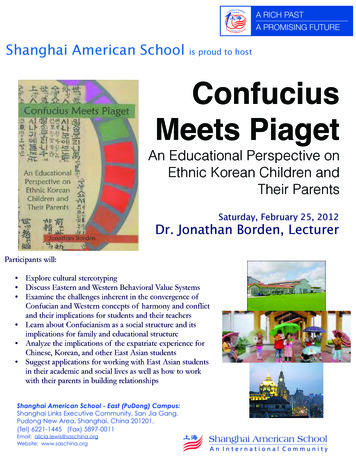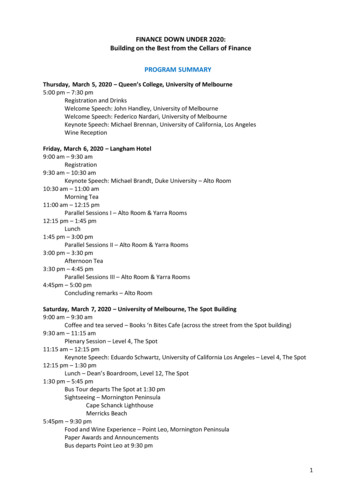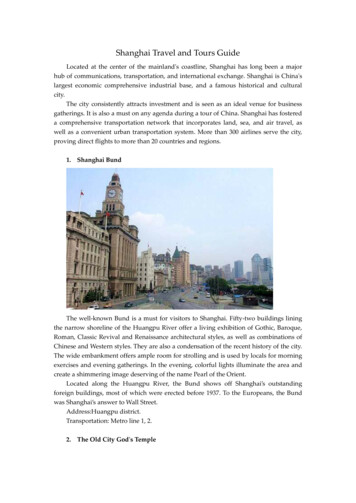
Transcription
Britannica International School, ShanghaiSecondary Long-Term Plan 2021-22Subject: EnglishYear: 8Teacher’s Name: Craig ArnoldTermWeek Beg.Januaryth10 JanuaryTopicThe Woman in BlackThe Woman in BlackTo understand the context of the novel and the gothic genre17thThe Woman in BlackTo understand chapter three and four3rdJanuaryLearning ObjectivesTo understand chapter two and analyse the gothic conventionsTo understand the use of characterisation and description of setting224th JanuaryThe Woman in BlackTo understand chapter fiveTo understand how to write an empathic letter14th FebruaryThe Woman in BlackTo understand chapter 6 and 7To understand the use of foreshadowing and the characterisation of Mr. Jerome21st FebruaryThe Woman in BlackTo understand chapter 8To understand the characterisation of Spider and the description of the nursery28thFebruary7th March14th March21st March28th MarchThe Woman in BlackTo understand chapter 9 and 10To understand how to create a gothic character and atmosphereThe Woman in BlackThe Woman in BlackThe Woman in BlackEND of TERM EXAMSTo understand chapter 11 and how to use implicit characterisationTo understand chapter 12 and how to write a book reviewTo understand the key themes of the bookEnd of unit assessment on The Woman in Black
Britannica International School, ShanghaiSecondary Long-Term Plan 2021-22Subject:MathematicsYear:8Teacher’s Name: Mr CliftonTerm Week Beg.3rd JanuaryTopicPatterns10th January17th JanuaryEquations andInequalities24th JanuaryReview214th FebruaryInvestigating Angles21st FebruaryLearning Objectives Generate terms of a sequence from a position-to-term rule Find the nth term of an ascending linear sequence Find the nth term of an descending linear sequence Use the nth term of a sequence to deduce if a given number is in a sequence Solve linear equations with the unknown on one side when calculating with negativenumbers is required Solve linear equations with the unknown on both sides when the solution is a wholenumber Solve linear equations with the unknown on both sides when the solution is a fraction Solve linear equations with the unknown on both sides when the solution is a negativenumber Solve linear equations with the unknown on both sides when the equation involvesbrackets Recognise that the point of intersection of two graphs corresponds to the solution of aconnected equation Solve missing angle problems involving alternate angles Solve missing angle problems involving corresponding angles Use knowledge of alternate and corresponding angles to calculate missing angles ingeometrical diagrams Establish the fact that angles in a triangle must total 180 Establish the size of an interior angle in a regular polygon Establish the size of an exterior angle in a regular polygon Solve missing angle problems in polygons
Britannica International School, ShanghaiSecondary Long-Term Plan 2021-22Subject:MathematicsYear:8Teacher’s Name: Mr Clifton28th FebruaryDecimals, Fractions andPercentages7th March14th March21st March28th MarchUnderstanding Risk II Identify the multiplier for a percentage increase or decrease when the percentage isgreater than 100% Use calculators to increase an amount by a percentage greater than 100% Solve problems involving percentage change Solve original value problems when working with percentages Solve financial problems including simple interest Solve problems that require exact calculation with fractions List all elements in a combination of sets using a Venn diagram List outcomes of an event systematically Use a table to list all outcomes of an event Use frequency trees to record outcomes of probability experiments Construct theoretical possibility spaces for combined experiments with equally likelyoutcomes Calculate probabilities using a possibility space Use theoretical probability to calculate expected outcomes Use experimental probability to calculate expected outcomesEND of TERM EXAMS
Britannica International School, ShanghaiSecondary Long-Term Plan 2021-22Subject: ScienceYear: Year 8Teacher’s Name: Ian LinsellTerm2Week Beg.3rd JanuaryTopicAtoms, Elements andCompoundsLearning Objectives10th JanuaryAtoms, Elements andCompounds17th JanuaryAtoms, Elements andCompoundsExplain the term ‘mixture’ and give examples of mixturesExplain the terms ‘pure’ and impure’Explain how air is separatedMid-Unit AssessmentTo define element, compound and mixtureTo identify elements, compounds and mixtures24th JanuaryAtoms, Elements andCompounds14th FebruaryAtoms, Elements andCompoundsTo state that pure substances have fixed melting and boiling pointsTo generate and use a temperature lineTo state the effect of impurities on melting and boiling pointBoiling point practicalLab reportTo be aware of the importance of the periodic tableThat the periodic table has developed since its discoveryMatter is made of atoms too small to be seen with the naked eyeAtoms are the smallest parts of elementsAn atom retains the property of the elementTo distinguish between the formulae for elements and compoundsTo know that a compound is made up of different elements chemically combinedTo represent the atoms in elements and compoundsTo identify elements and compoundsTo know that the properties of elements change when they are part of a compoundTo write the chemical equations for some reactionsTo know the signs of a chemical reactionTo use peer-assessment to show that a chemical reaction has taken placeTo distinguish between chemical reactions and physical changes
Britannica International School, ShanghaiSecondary Long-Term Plan 2021-22Subject: ScienceYear: Year 8Teacher’s Name: Ian LinsellThat elements fit into groupsThat there are patterns of behaviour in groups21st February28th FebruaryHeat and MagnetismHeat and MagnetismThat materials can feel warm or cool because of their physical properties as well as theiractual temperatureThat temperature is a measure of how hot an object isThat the temperature of an object can be measured using a thermometerThat there are a range of different types of thermometer and each type is suitable fordiffering types of measurementThat an object warms up when it gains thermal energy from its surroundings and cools downwhen it loses energy to its surroundingsThat the temperature of an object is a measure of the average thermal energy of a particlein the object and the total thermal energy depends on this and the size of the objectThat a thermal conductor is a material that transfers thermal energy quickly and metals aregood thermal conductorsThat a thermal insulator is a material that transfers thermal energy slowly and that examplesinclude wool, plastics and wood7th MarchHeat and MagnetismThat when materials are heated the particles in the material gain energy and move furtherapartThat thermal energy can be transferred through a material by conduction processesThat thermal energy can be transferred by radiation and this is the only way thermal energycan travel through a vacuumThat convection currents carry thermal energy through fluids owing to changes in densityThat some materials are magnetic while others are notThat magnets have two poles named ‘north’ and ‘south’
Britannica International School, ShanghaiSecondary Long-Term Plan 2021-22Subject: ScienceYear: Year 8Teacher’s Name: Ian LinsellAbout the interactions and forces between north and south poles of a magnet14th March21st MarchHeat and MagnetismHeat and MagnetismHow permanent magnets can be made using strong magnetsAbout methods for testing the strength of a magnetThat magnets have a field round them that can be represented in a diagramThat magnets interact with each other through these fieldsThat an electric current produces a magnetic fieldThat the strength of the field is increased in a coilThat increasing the current, the number of loops in the coil and adding a magnetic core canincrease the strength of the magnetic fieldThat the shape of a magnetic field around the electromagnet is similar to that around a barmagnetAbout the applications of an electromagnetRevision28thMarchEND of TERM EXAMS
Britannica International School, ShanghaiSecondary Long-Term Plan 2021-22Subject: GeographyYear: 8Teacher’s Name: Chris DavisTermWeek Beg.3rd January10th JanuaryTopicPopulation growthcausesPopulation distribution17th JanuaryPopulation locations24th JanuaryMigration causes14th FebruaryMigration effects21st FebruaryHistory of population28th FebruaryPopulation andsettlementPopulation researchprojectPopulation researchprojectReviewEND of TERM EXAMS27th March14th March21st March28th MarchN/AN/ALearning ObjectivesExplain the causes of population growthEvaluate the relative importance of these causesDescribe the world’s population distributionExplain the world’s population distributionExplain why humans populate certain areasCompare/contrast different population locationsDescribe different types of migrationExplain why people migrateDescribe the effects of migrationEvaluate the positive/negative effects of migrationDescribe the main trends of historic population growthExplain why modern population growth is unprecedentedIdentify different types of human settlementExplain why human populations have become more urbanisedResearch the population trends of a selected regionPresent findings to peersResearch the population trends of a selected regionPresent findings to peers
Britannica International School, ShanghaiSecondary Long-Term Plan 2021-22Subject: HistoryYear: 8Teacher’s Name: Chris DavisTerm3rdWeek Beg.JanuaryTopicLife in Tsarist Russia10th January1905 Revolution17th JanuaryRasputin24th JanuaryRussia in WW114th FebruaryFebruary Revolution21st FebruaryOctober Revolution28th FebruaryBolshevik success7th MarchLenin’s Russia14th MarchStalin’s Russia21st March28th MarchReviewEND of TERM EXAMS2N/AN/ALearning ObjectivesDescribe the main political, economic and social features of Tsarist RussiaExplain why these features made a revolution more likelyExplain the causes of the 1905 RevolutionEvaluate the extent to which this revolution was a successInvestigate Rasputin’s life and role in politics using evidenceJudge the extent to which Rasputin was responsible for further revolutionsEvaluate the success/failure of Russia’s participation in WW1Explain why Russia’s performance in WW1 made another revolution likelyExplain how/why the Tsarist government was overthrownCompare/contrast the different ideologies of political groups in 1917Describe the key events of the October RevolutionEvaluate whether this was a ‘revolution’ or a ‘coup’Describe the main factions and theatres of the Russian Civil WarExplain why the Bolsheviks eventually wonInvestigate the quality of life under Lenin using sourcesExplain how Lenin tried to rebuild Russia after the Civil WarCompare/contrast Stalin’s policies with Lenin’sEvaluate the extent to which life in Russia had improved between 1900 and 1939
Britannica International School, ShanghaiSecondary Long-Term Plan 2021-22Subject:Art & DesignYear:8Teacher’s Name: Ineke OosthuizenTerm2Week Beg.3rd January10th January17th JanuaryTopicIntroduction to Chineseink paintingTracingLearning ObjectivesThe students are introduced to Chinese ink painting.Practical:The students use Chinese ink painting to practice line, value and natural shape whilelearning to use a new material.The students will learn to trace objects and images and learn how this can improve theirdrawing skills.Practical:The students will trace objects and images to improve accuracy and detail.24thJanuaryShading Extension - Higher ability students will be given the task of observational drawing.The students will shade the objects they traced.Practical:To practice shading students will shade the images and objects that they traced. This helpsimprove their understanding of form and makes for more accurate drawings.14thFebruary21st FebruaryRosalind Monks Extension – Higher ability students will draw and shade from observation.The students will learn about Rosalind Monks and her Zentangle insects.Practical:The students will replicate Zentangle insects in the style of Rosalind Monks.Extension – Higher ability students will be given the task of drawing Zentangle animals.
Britannica International School, ShanghaiSecondary Long-Term Plan 2021-22Subject:Art & DesignYear:8Teacher’s Name: Ineke Oosthuizen28th February7th MarchPattern cactusesThe students will draw and paint potted cactuses.Practical:Drawing and patterning cacti, practice line drawing and practice using art tools.14th March21st March28th MarchTie dyeThe students will learn to make tie dye cloth using different folding techniques.Practical:The students fold and dye cloth using multiple different methods. Extension – the students could paint on their cloth using fabric paints.
Britannica International School, ShanghaiSecondary Long-Term Plan 2021-22Subject: Computer ScienceYear: 8Teacher’s Name: Laurence BellTermWeek Beg.3rd January10th January217th JanuaryTopicIntroduction to PythonParameters andCoordinates:Introduction to PythonVariables:Introduction to PythonLists and Methods:24th JanuaryIntroduction to PythonAgent and Loops:14th FebruaryIntroduction to PythonConditionals andBooleans:Introduction to PythonWhile-loops andSequences:Introduction to PythonFunctions:21st February28th FebruaryLearning ObjectivesCommand Structure and SyntaxThe CEO of Coding Mine needs your students’ help correcting bugs. Learners write down MinecraftPython commands using proper syntax, then find and correct errors in existing pieces of code.Students need to write down Python commands to place blocks in the right locations in a threedimensional space and find the most efficient way to construct objects.Students need to help Coding Mine with the development of their new farming software. Thissoftware will help farmers in every step of the farming process, from planting and sorting to sellingthe produce.Students help Coding Mine with the development of new software for an animal hospital.Veterinarians need help to easily identify and categorize animals, then prescribe different treatmentsand dietary requirements.CodingMine wants to code the Agent so it can drive a car by itself. That means the Agent needs tomake decisions and analyze the road for any obstacles and signs. Students code the Agent to addressseveral simulated traffic situationsThe Agent needs to help out in emergencies by building multiple structures like water barriers,firebreaks, and reconstructed house foundations. Students code the Agent to respond to simulatedsituations until the software is advanced enough to try out in the real world.An ecological organization wants to plant a large number of trees on a deadline, but it’s not an easyjob to prepare the soil to plant pastures of saplings. The developers have been having someproblems with their code, and need your students’ help.7th MarchIntroduction to PythonFunctions:Recap, finish off.14th MarchAnimation for apurposeSs will be introduced to a graphic editor (Fireworks). Ss to create a folder and save the templatedocument into it. Plan. Ss to write short transcript of animation. Highlight key stages.Ss to show working knowledge of appropriate file formats.21st MarchEND of TERM EXAMS
Britannica International School, ShanghaiSecondary Long-Term Plan 2021-22Subject: Computer ScienceYear: 8Teacher’s Name: Laurence Bell28th MarchAnimation for apurposeTeacher illustrates how to create a basic ‘animate gif’ in Fireworks from template. Ss to make use of layers and frames and image editing tools.Ss to adapt an appropriate picture, considering size, shape and color.
Britannica International School, ShanghaiSecondary Long-Term Plan 2021-22Subject: MusicYear: 8Teacher’s Name: Richard DorringtonTermWeek Beg.JanuaryTopicLearning ObjectivesIntroduction to Blues topic, historical and cultural context. Introduction to walkingBass line and 12 bar blues structure.Understanding syncopation in Blues, listening and recognising various elementsincluding improvisation.3rdBlues Project10th JanuaryBlues Project17th JanuaryBlues ProjectPlaying as part of a duet, LH walking bassline and RH major chords and dominant seventhchords.24th JanuaryBlues Project14th FebruaryBlues21st FebruarySamba28th FebruarySamba7th March14th March21st March28th MarchSambaSambaSambaSambaPracticing as part of a duet, playing both roles and understanding musicianship andtiming.Improvising using minor pentatonic and blues scale over a 12-bar blues walking bassline.Introduction to Samba Drumming, instruments and rhythms/ Background andhistorical context.Continuation of historical and cultural context. Opportunity to play each instrumentinvolved with Samba Percussion playing.Second whole class Samba Bateria, with various sections included.Improvised solos added to whole class sambaForm groups within the class and work towards a performance.Perform final performance to the rest of the class.2
Britannica International School, ShanghaiSecondary Long-Term Plan 2021-22Subject: Physical EducationYear: 8 & 9Teacher’s Name: Ashley Nicholas & Anthony ChevrierTerm2Week Beg.JanuaryTopic3rdAthletics10th JanuaryAthletics17th JanuarySwimming24th JanuarySwimming14th FebruarySwimming21st FebruarySwimming28th FebruarySwimming7th MarchSwimming14th MarchStriking and FieldingLearning ObjectivesTo learn the safety aspects when performing, e.g., how to land, warm up properly as well aslearn how to perform a basic accurate legal jump with consistent distance. To developknowledge and understanding on how to measure accurately and improve distance.To learn how to evaluate own and others performance and provide constructive feedback toimprove performance.To learn the safety rules and procedures for using the Britannica pool as well as develop thefront crawl technique over short distances and understand two different shapes for enteringdeep water.To learn how interval training can be used to w/up in swimming. To develop the basic backcrawl start leading into leg kick as well as basic sculling action over short distances.To learn the key teaching points for back crawl arm action as well as develop the armtechnique for back stroke over short distances.Too understand the importance of “turning feet out” for swimming breaststroke. To learnthe key teaching points for swimming breaststroke leg action as well as understand amethod of jumping into water whilst keeping the head above water.To learn several methods for treading water as well as understand the favourite method oftreading water. To learn about the different methods which help maintain body heat inwater.To develop the 25m Back crawl with good technique as well as basic surface diving actioninto deep water. To learn the key teaching points for swimming Breaststroke as well asunderstanding the names and locations of several main muscle groups.To learn how to adapt and develop skills as well as apply more specific techniques inactivities in order to improve consistency, quality and use of techniques for a specificpurpose.
Britannica International School, ShanghaiSecondary Long-Term Plan 2021-22Subject: Physical EducationYear: 8 & 9Teacher’s Name: Ashley Nicholas & Anthony Chevrier21st MarchStriking and Fielding28th MarchEND of TERM EXAMSTo learn how to apply strategic and tactical principles more effectively in familiar situationsas well as anticipate and respond to situations.
Britannica International School, ShanghaiSecondary Long-Term Plan 2021-22Subject: Native MandarinYear: Year 8Teacher’s Name: Lily HuangTermWeek Beg.3rd January春Topic10th January春2Learning Objectives1 积累词语2 体会春天的美好3 �作用1 Accumulate words2 Understand the beauty of spring3 Understand the role of metaphor and anthropomorphism in highlighting the characteristics ofscenery1 运用写作方法介绍喜欢的景色2 片段写作:春天1 Use different writing methods to introduce favorite scenery2 Writing: Spring17th January济南的冬天1 积累词语,2 了解散文的特点3 �作用1 Accumulate words,2 Understand the characteristics of prose3 Understand the role of metaphor and anthropomorphism in highlighting the characteristics ofscenery24th January14th February彩排Chinese New Year rehearsal济南的冬天1 运用写作方法介绍喜欢的景色2 习作《我的校园》1 Use different writing methods to introduce favorite scenery2 Writing "My Campus21st February论语十二章1 �语,积累文言实词和虚词2 ��修身的道理。
Britannica International School, ShanghaiSecondary Long-Term Plan 2021-22Subject: Native MandarinYear: Year 8Teacher’s Name: Lily Huang28th February论语十二章7th March散文诗二首14th March散文诗二首3 朗读并背诵课文1 Learn the new words and expressions in the first part of "The Twelve Chapters of theAnalects" and accumulate content and function words in classical Chinese2 Combining the introduction to Confucius' life and thoughts, correctly understand thecontent of each chapter, and experience the principles of learning and self-cultivationadvocated in it.3 Read and recite the text aloud1 �语,积累文言实词和虚词2 ��修身的道理。3 朗读并背诵课文1 Learn the new words and expressions in the second part of "The Twelve Chapters of theAnalects" and accumulate content and function words in classical Chinese2 Combining the introduction to Confucius' life and thoughts, correctly understand thecontent of each chapter, and experience the principles of learning and self-cultivationadvocated in it.3 Read and recite the text aloud1 积累词语2 �语言特点3 朗读诗歌,感受作品的美好意1 Accumulate words2 Grasp the thought content, emotional tone, and language characteristics of prose poems3 Read poems aloud and feel the beauty of the work1 积累词语2 �语言特点3 朗读诗歌,感受作品的美好意义1 Accumulate words2 Grasp the thought content, emotional tone, and language characteristics of prose poems
Britannica International School, ShanghaiSecondary Long-Term Plan 2021-22Subject: Native MandarinYear: Year 8Teacher’s Name: Lily Huang3 Read poems aloud and feel the beauty of the workMarch紫藤萝瀑布28th March紫藤萝瀑布21st1 积累词语2 。1 Accumulate words2 Compare the changes before and after Wisteria sinensis, and combine the wordsand sentences that show the author's emotional changes, sort out the context ofthe article, and grasp the content of the article as a whole.3. Combine the key sentences of the article, understand the author's sentiment, andform your own understanding.1 ��读方法。3 写作:月亮1 Transfer the learned methods to read "Lilac Knot" and "A Good Hibiscus Flower", read andcompare the scene-like paragraphs, and summarize the writing characteristics from thelanguage characteristics and writing methods.2. Taste the key sentences, understand the relationship between things and people,understand the author’s ambitions and their common characteristics in comparative reading,and learn how to read prose prose.3 Writing: Moon
Britannica International School, ShanghaiSecondary Long-Term Plan 2021-22Subject: MandarinYear: KS3 Level 1Teacher’s Name: Elaine FuTermWeek Beg.3rd JanuaryTopicCNY Performance10th January17th January24th January14th FebruaryPinyin21st FebruaryPinyin & Strokes28th FebruaryNumbers7th MarchMoon Festival14th MarchGreetings2Learning Objectives Rehearsal for CNY Performance Understand how the pinyin system helps to learn Chinese.Identify the three components of a pinyin syllable: the initial, the final and the tonePronounce the Initials and Finals correctly.Pronounce the four tones in Mandarin.Pronounce a pinyin syllable correctly according to its spelling.Identify and write 12 basic strokes that compose Chinese characters.Count from 1-99Recognise and write the characters: �、十Know the stroke order of writing Chinese characters and practice it when writing.Know the customs and traditions of Moon Festival in Chinese.Know about the traditional story of Moon Festival about Hou Yi & Chang E.Understand why it is an important festival in Chinese culture.Say Moon Festival greetings.Greet people using the sentences and phrases you learned.Exchange your names when meeting a person for the first time using the sentences youlearned.Recognise and write the characters required as listed: 你好 您好 再见 什么 名字 小月 大 生 Know about the radicals of Chinese characters and how they compose Chinesecharacters. Learn three radicals: 单人旁、女字旁、心字底
Britannica International School, ShanghaiSecondary Long-Term Plan 2021-22Subject: MandarinYear: KS3 Level 1Teacher’s Name: Elaine Fu21st MarchEnd-of-term Revision 28th MarchEND of TERM EXAMS
Britannica International School, ShanghaiSecondary Long-Term Plan 2021-22Subject: MandarinYear: KS3 Level 2Teacher’s Name: Jane QueTermWeek Beg.Januaryth10 January17th January24th January14th February3rdTopicCNY PerformanceRehearsal for CNY PerformanceCNY PerformanceRehearsal for CNY PerformanceSickness 2Learning Objectives 21st28thFebruaryFebruary7thMarchth14 obby(3)Dance 28thMarchEnd-of-term RevisionDescribe some symptoms when feeling unwell.maintain a conversation when seeing a doctor.Recognise and write the characters: �服,嗓子,感冒,休息,想要.Learn the simple characters: 弓,田,自己。Name a range of hobbies related to music or art.Expression of the length of time. To tell how long that one does an activity for.Produce sentences with some more complex sentence structures.Recognise and write the characters: 爱好、一边 ��彩画儿、都、正在。Learn the simple characters: 包、止、士、豆。Name a range of hobbies related to sports and TV.Produce sentences with some more complex sentence structures.Recognise and write the characters: earn the simple characters: 夕、心、目、方。Name a range of hobbies related to dance.Ask questions with the question words 什么时候(when) and 干什么(do what).Write a paragraph on the topic “My Hobbies” using slightly complex sentence structures learned.Recognise and write the characters: 除了 以外、舞蹈、从 ��场。Learn the simple characters: 平、土、角、页。
Britannica International School, ShanghaiSecondary Long-Term Plan 2021-22Subject: MandarinYear: KS3 Level 2Teacher’s Name: Jane QueEND of TERM EXAMS
Britannica International School, ShanghaiSecondary Long-Term Plan 2021-22Subject: MandarinYear: KS3 Level 3Teacher’s Name: Chris LiuTermWeek Beg.3rd January10th January24th January29th January214th FebruaryTopicCNY PerformacnePractiseLearning ObjectivesLearning Chinese songs and culture.Rehearsal for CNY PerformanceCNY PerformacneChinese New YearOccupation121st February28th February7th MarchOccupation214th March21st March28th MarchEnd-of-term ProjectEnd-of-term RevisionEND of TERM EXAMS Be able to named and write various occupations in Mandarin:经理、律师、工作Be able to named and write various clothes: �鞋 To tell what jobs you like or don’t like and why:特别,非常,还 Be able to use sentence patterns to express a preference at shopping shops:最好 Be able to named and write various occupations in 家、工程师 Be able to ask someone’s job:你做什么工作? Be able to say how to go to �� Be able describe 、发脾气Topic: Ocupations
Britannica International School, ShanghaiSecondary Long-Term Plan 2021-22Subject: MandarinYear: KS3 Level 4Teacher’s Name: Sandy WANGTermWeek Beg.3rd January10th JanuaryTopicCNY PerformanceChinese New Year17th January24th January14th FebruaryChinese New YearChinese New Year21st February28th FebruaryChinese New Year Feast7th March14th MarchTravelling duringChinese New YearHolidays Learning ObjectivesUnderstand classroom instruction in Chinese.Practice listening skillsRemember words related to Days before Chinese New YearPractice reading skillsUnderstand texts and answer questions related to texts2Rehearsals Understand classroom instruction in Chinese. Practice listening skills Remember words related to Celebrations for Chinese New Year Practice reading skills Understand texts and answer questions related to texts Writing: Write an e-mail to your friends about your Chinese New Year Holidays Understand classroom instruction in Chinese. Practice listening skills Remember words related to Chinese New Year Feast Practice reading skills Communication: Dining in the restaurant Understand texts and answer questions related to texts Understand classroom instruction in Chinese. Practice listening skills Remember words related to Celebrations for Chinese New Year Practice reading skills Understand texts and answer questions related to texts Writing: Write a dairy of your weekends
Britannica International School, ShanghaiSecondary Long-Term Plan 2021-22Subject: MandarinYear: KS3 Level 4Teacher’s Name: Sandy WANG21st March28th MarchEnd-of-term RevisionEND of TERM EXAMS
Britannica International School, Shanghai Secondary Long-Term Plan 2021-22 Subject: Science Year: Year 8 Teacher's Name: Ian Linsell Term Week Beg. Topic Learning Objectives 2 3rd January Atoms, Elements and Compounds Matter is made of atoms too small to be seen with the naked eye










